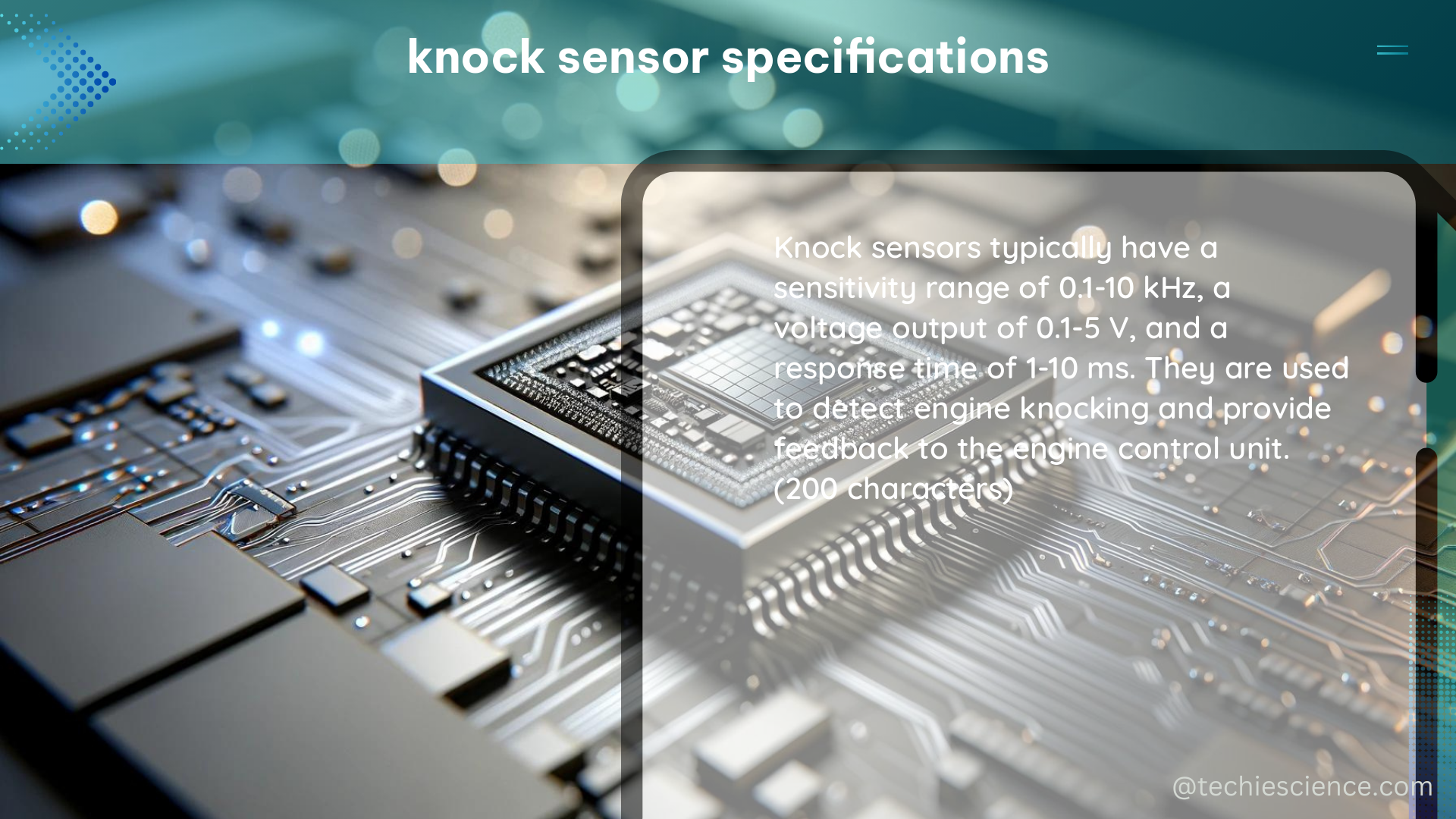Knock sensors are critical components in modern internal combustion engines, designed to detect knocking or pinging, which can lead to engine damage. The specifications of knock sensors can vary based on the manufacturer, engine type, and application, but they all share common characteristics that ensure reliable and accurate performance.
Sensitivity and Frequency Response
The sensitivity of a knock sensor is a crucial specification that determines its ability to detect knocking or pinging in the engine. Typically, knock sensors have a sensitivity range of 10 to 100 millivolts (mV) per knock event. This means that for every knock event, the sensor will generate an output voltage signal within this range, which can then be processed by the engine control unit (ECU) to identify and mitigate the knocking condition.
In addition to sensitivity, the frequency response of a knock sensor is equally important. Knock sensors should have a frequency response range of 5 to 15 kilohertz (kHz) to effectively capture the high-frequency knocking signals generated during combustion. This wide frequency range allows the sensor to detect a wide variety of knocking patterns, ensuring accurate and reliable knock detection.
Operating Voltage and Temperature Range

Knock sensors typically operate at a voltage range of 9 to 16 volts, depending on the engine’s operating conditions. This voltage range ensures that the sensor can function reliably across a variety of engine configurations and power supply variations.
The temperature range of a knock sensor is another critical specification. Knock sensors should be able to operate within a temperature range of -40 to 150 degrees Celsius (-40 to 302 degrees Fahrenheit) to ensure reliable operation in various environmental conditions, from extreme cold to high-heat engine compartments.
Mounting Torque and Signal Conditioning
The mounting torque of a knock sensor is an important consideration to prevent damage to the sensor during installation. The recommended mounting torque should not exceed 15 foot-pounds (ft-lbs) to ensure a secure and safe installation.
Knock sensors require signal conditioning to convert the sensor’s output into a usable signal for the ECU. This signal conditioning typically involves amplification, filtering, and rectification to remove noise and ensure a clean, reliable signal for further processing.
Signal Processing and Response Time
The ECU processes the conditioned knock sensor signal using advanced algorithms to detect knocking events. These algorithms include short-time Fourier transform, wavelet-denoising, and empirical mode decomposition (EMD) to analyze the frequency content of the signal and identify the characteristic patterns of knocking.
The response time of a knock sensor is also a critical specification, as it determines the sensor’s ability to detect knocking events in a timely manner. The response time should be less than 10 milliseconds (ms) to ensure prompt detection and mitigation of knocking conditions.
Durability and Reliability
Knock sensors must be able to withstand the harsh environment of an internal combustion engine, including high temperatures, vibrations, and mechanical shocks. Manufacturers design knock sensors with robust materials and construction to ensure long-term durability and reliable performance.
Some key durability specifications for knock sensors include:
- Operating temperature range: -40 to 150°C (-40 to 302°F)
- Vibration resistance: Up to 30 g (acceleration due to gravity)
- Shock resistance: Up to 50 g (acceleration due to gravity)
- Corrosion resistance: Able to withstand exposure to engine oils, coolants, and other fluids
By meeting these stringent durability requirements, knock sensors can continue to provide accurate and reliable knock detection throughout the engine’s lifetime, ensuring optimal performance and preventing potential engine damage.
Conclusion
Knock sensor specifications are critical to the proper functioning of modern internal combustion engines. From sensitivity and frequency response to operating voltage, temperature range, and durability, each specification plays a vital role in ensuring accurate knock detection and effective engine control.
By understanding the technical details and requirements of knock sensor specifications, engine designers, technicians, and enthusiasts can ensure that the knock sensors in their engines are performing at the highest level, contributing to improved engine efficiency, performance, and longevity.
References
- A new knock event definition for knock detection and control optimization
- The engine knock analysis – An overview
- Development of Pattern Recognition Knock Detection System using Short-time Fourier Transform
- Knock Sensor Specifications and Characteristics
- Understanding Knock Sensors: How They Work and Why They Matter

The lambdageeks.com Core SME Team is a group of experienced subject matter experts from diverse scientific and technical fields including Physics, Chemistry, Technology,Electronics & Electrical Engineering, Automotive, Mechanical Engineering. Our team collaborates to create high-quality, well-researched articles on a wide range of science and technology topics for the lambdageeks.com website.
All Our Senior SME are having more than 7 Years of experience in the respective fields . They are either Working Industry Professionals or assocaited With different Universities. Refer Our Authors Page to get to know About our Core SMEs.